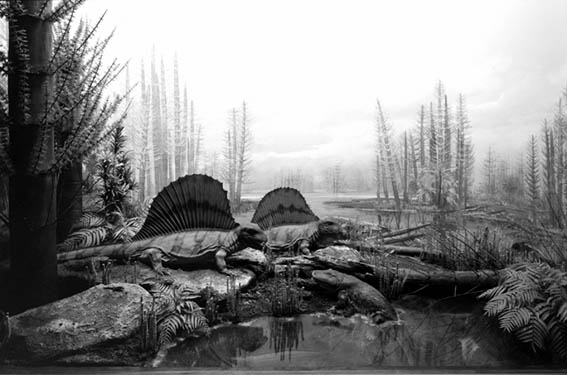Essay by Jodie Becker
HIROSHI SUGIMOTO
Hiroshi Sugimoto was born in Tokyo, Japan in 1948. He finished university in 1970, his initial studies were Politics/Socialogy and not photography related at all. He later retrained himself with a BFA in Fine Arts at the Art Center College of Art and Design in Los Angeles, California, which he graduated from in 1974. He then moved to New York, however he spreads himself between American and Japan, which is reflected in his photographs.
Many of Sugimoto’s photography themes are often related to the flow of time, life and death, surrealism and fascination with science/math. He uses a large format camera and has an exceptional technical ability but is also admired for the philosophical connections that form the conceptual ideas in his work. Most often he does photographic series. He often likes to question ones sense of reality, especially when it is commonly perceived that a photograph only captures the truth. Sugimoto never photographs living people, his subjects are statues, models, landscape, sculpture and architecture. He prefers to shoot with natural lighting and will avoid using studio lighting where possible, he also prefers his exhibitions to be bathed in natural light and does not concern himself with the deterioration of the images as he believes this is a natural flow of life.

Permian Land, 2004
DIORAMAS
When visiting the American Musuem of Natural History in New York, Sugimoto observed that the stuffed animals against painted backgrounds looked tragically fake, but when he squinted one eye, the perspective would vanish and it looked more realistic. He thought that perhaps this is how the camera would see the image and set about making the Diorama series. At a first glance the images do look real but when you notice creatures such as dinosaurs, you realise they do not exist in the world today and therefore the image cannot be a real living creature that has been captured by the camera.

Sea of Japan, Hokkaido, 1986
SEASCAPES
At a first glance, the series of Seascapes look quite simple. Calm compositions divided equally between the water and sky. But the philosophy behind them is wonderfully thought out.
“Water and air. So very commonplace are these substances, they hardly attract attention - and yet they vouchsafe our very existance” (Hiroshi Sugimoto)
The way each seascape has been photographed makes it ambiguous to it’s location, with only the title tying it to the place of capture. Longer shutterspeeds have been used on some of the images, which as a result have a soft ethereal quality to them, where the waves and sky have drifted together during the exposure time. While each photograph has been framed the same way, each has it’s own quality in the variation of shutterspeeds and the type of weather present at the scene.

Metropolitan, 1993
THEATRES
Sugimoto had an interesting thought session that led to the question “Suppose you shoot a whole movie in a single frame?” where of course the answer is “You get a shining screen”. He took action to realise this vision and began experimenting by taking his camera to a theatre, where he set the shutter open, only to click it closed when the movie had finished. He developed the film the same night and was completely amazed by the result. He has since photographed many different theatres in this fashion, being lit by only the light of the movie itself which becomes an indistinguishable white screen but therefore condensing the whole movie to one frame, collapsing time into what seems like a single moment. The theatres which are usually filled with people during a movie screening, look quite eerie as they are empty in Sugimotos photographs.

Mathematical Form 0003, 2004.
Dini's surface: a surface of contant negative curvature obtained by twisting a pseudosphere.
MATHEMATICAL FORMS
Sugimoto has a fascination in mathematical sculptures and the beauty they create without being intentional pieces of art work. “Art resides even in things with no artistic intentions” (Hiroshi Sugimoto). The objects known as “stereometric exemplars” were used as teaching aids to demonstrate trigonometric functions to students. They have been photographed in a way that they appear as abstract statuesque monuments against a black background, giving the viewer no clue as to the real size of the object and therefore perceived as being very large as they dominate the frame.

Anne of Cleves, 1999
PORTRAITS
The famous wax museum Madame Tussuads has many historical figures that have been made with only renaissance paintings as reference, as photography did not exist in their era. Sugimoto has then photographed these figures with renaissance style lighting to immitate the paintings, yet the photographs turn out looking as though a real person could be standing in front of the camera. Many levels of different art mediums imitating each other makes us question the sense of reality in the photographs. Sugimoto himself has said “If this photograph no appears lifelike to you, you had better reconsider what it means to be alive here and now.”
Many of Sugimoto’s themes challenge your perception of reality in his photographs. The ideas of art and science are being intermingled into one. His beautiful execution of the images also indicates his understanding of the interrelation between science and art and not just his ability to pose questions about it. There’s a dreamy quality in his photographs that also demands us to acknowledge the here and now. The metaphysical philosophy that drives his choice of subject matter creates a story behind each image that makes the viewer question their perception of time, space and self. These questions and themes are very evident in his series Dioramas, Seascapes, Mathematical Forms, Portraits and Theatres.
REFERENCES
ARTINFO, Lightning Fields, retrieved 20 April 2011,
Art Knowledge News, Lucerne Museum of Art displays a Hiroshi Sugimoto Retrospective, retrieved 20 April 2011,
Thomas Kellein, Hiroshi Sugimoto : Time Exposed, 1995, Thames & Hudson.















































